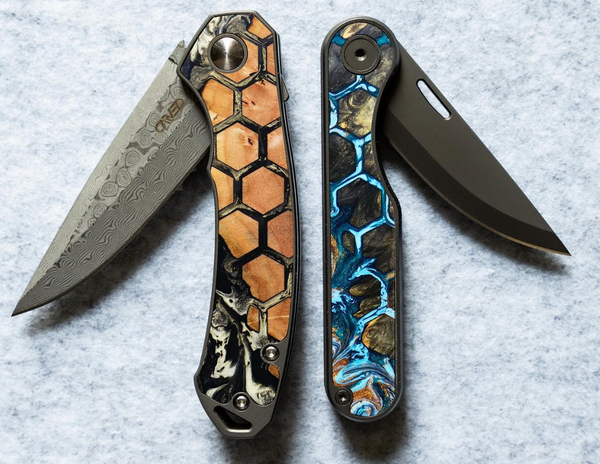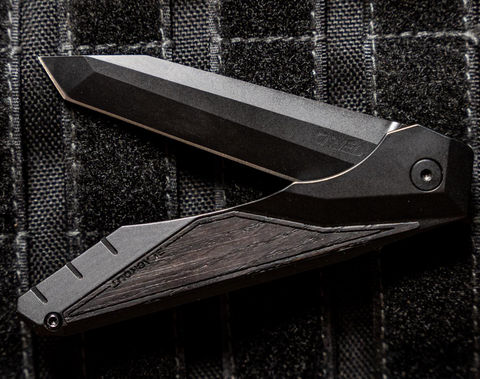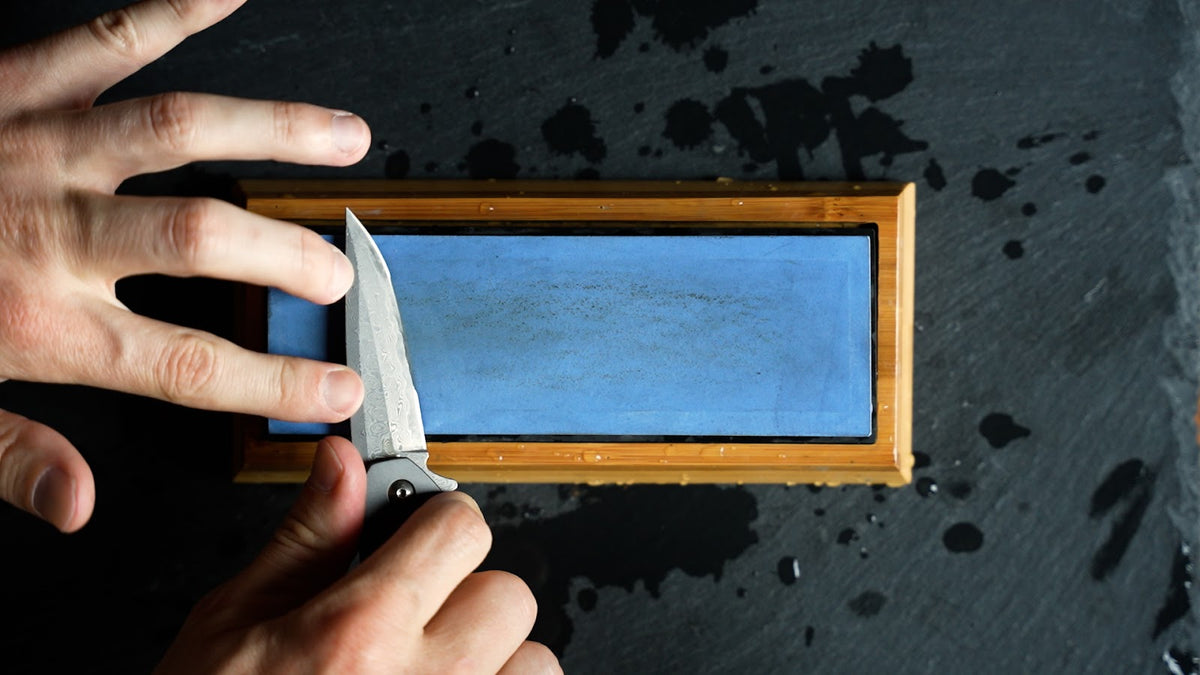
Pocket knives are a staple tool for everyday carry (EDC) enthusiasts, manual laborers, and hobbyists alike. No matter what you need, your trusty blade is always there for you, as long as you take good care of it. But if you don’t regularly clean or sharpen the pocket knife, the general lack of maintenance will come back to bite you when you need it most.
So how do you clean your pocket knife? And how do you sharpen it? We’re going to show you how to take care of your knife with routine maintenance so that your blade remains sharp & strong for years to come.
How to Clean Your Pocket Knife
Keeping your pocket knife clean is essential for maintaining its functionality and preventing any potential issues. Let's discuss the importance of regular cleaning, the supplies you'll need, and the step-by-step process for cleaning your EDC folding knife.
Supplies Needed for Cleaning
To clean your pocket knife, you’ll need the following supplies:
-
Mild Dish Soap – Choose a gentle dish soap that is free from harsh chemicals and abrasives. It will remove dirt & grime without damaging the blade or handle, nor will it leave behind a sticky residue.
-
Warm Water – To pair with the mild dish soap, it will help break down dirt accumulation and make it generally easier to clean the tool.
-
Soft Brush or Toothbrush – Use a soft-bristled brush or an old toothbrush to scrub away hard-packed dirt and debris from the knife. The bristles will help you reach the fine cracks & crevices in between parts as well.
-
Toothpicks or Cotton Swabs – If you can’t remove all of the debris with the bristle brush, grab a toothpick or cotton swab to clean the hard-to-reach areas.
-
Rust Prevention Oil – Apply an anti-rust oil after cleaning to help protect the blade from corrosion after moisture exposure.
- Lint-Free Cloths – To dry & polish your knife once you’ve finished cleaning it.
By following these steps, you can effectively clean your blade, handle, and pivot point to ensure they all remain in top-notch condition.
The Cleaning Process
Now that you have your supplies ready, follow these steps to clean your pocket knife:
-
Disassemble the Knife – If you have a folding pocket knife, carefully disassemble it by opening the blade and removing any screws or pins. Note the order in which the parts are removed to facilitate reassembly later. If it’s helpful, place them on a paper towel with labels to help you remember.
-
Remove Loose Dirt and Debris – Use a soft brush or toothbrush to gently brush away any loose dirt or debris from the blade, handle, and other parts of the knife. Pay attention to hinges, pivot points, and locking mechanisms.
-
Prepare the Cleaning Solution – Fill a basin or sink with warm water and add a small amount of mild dish soap. Mix well to create a soapy solution.
-
Clean the Blade and Handle – Submerge the blade and handle of your pocket knife in the soapy water. Gently agitate the knife to loosen any remaining dirt or grime. Use a soft brush or toothbrush to scrub the surfaces, paying extra attention to crevices and hard-to-reach areas.
-
Rinse Thoroughly – Once you have finished scrubbing, rinse the knife under running water to remove any soap residue. Ensure that all traces of soap are washed away.
-
Dry and Polish – Use a lint-free cloth to thoroughly dry the blade, handle, and other components of your pocket knife. Wipe away every ounce of moisture to prevent rust & corrosion.
-
Apply Rust Prevention Oil – Apply a thin layer of anti-rust oil to the blade and other metal parts of your pocket knife. This helps protect against corrosion and keeps the knife in optimal condition.
- Reassemble the Knife – Once everything is dry and oiled, carefully reassemble your pocket knife, making sure all components fit back together correctly. Tighten any screws or pins securely, being sure to avoid over-tightening. You may apply lubricant as needed to the hinges, as the soapy solution will have removed whatever amount was present before cleaning.
Why Regular Cleaning is Necessary
Regular cleaning of your pocket knife is necessary for several reasons:
-
Hygiene – If you use your pocket knife for everything (like we do), it’s bound to come into contact with all kinds of substances, like dirt, food particles, and even bodily fluids. By cleaning your knife regularly, you can prevent the buildup of bacteria on the blade, hinge, and handle. More so, you can prevent the transfer of those dirty substances onto other surfaces, like fresh game or an open wound.
-
Prevent Corrosion – If your knife blade is made of steel or other metals, it’s susceptible to corrosion when exposed to moisture or acidic substances. This applies especially to fishers, hunters, or outdoorsmen, where your knife is constantly exposed to the elements. Regular cleaning, preferably immediately after exposure, removes any residue that could lead to corrosion and helps prolong the lifespan of your knife.
- Maintain Performance – Over time, dirt and debris can accumulate in the moving parts of your pocket knife, slowing its release or preventing it entirely. A simple cleaning will ensure that your knife continues to open & close efficiently.

How to Sharpen Your Pocket Knife
A dull blade is useless. So if you’ve already gone through the cleaning process, you should sharpen your pocket knife as well. There are a few ways to do this, but let’s start with finding the proper sharpening tool.
Best Knife Sharpening Tools
There are various tools you can use to sharpen your pocket knife blade:
-
Sharpening Stones – Also known as whetstones, these tools are the simplest, and arguably the most effective, way to sharpen your blade. They come in different grits, ranging from coarse to fine, allowing you to gradually refine the edge of your knife. Check out our full guide: How to Sharpen Your EDC Knife with a Whetstone.
-
Sharpening Systems – Sharpening systems consist of guided systems that hold the knife at a fixed angle to ensure consistent and precise sharpening. They often include sharpening stones or diamond plates to achieve the desired sharpness.
-
Sharpening Rods – Also called honing rods or sharpening steels, these rods help maintain relative sharpness in between routine sharpening sessions. They’re typically made of steel or ceramic and help realign the edge of the blade.
- Electric Knife Sharpeners – Electric knife sharpeners are convenient, quick, and effective. They typically have built-in sharpening guides and abrasive wheels or belts that quickly sharpen the blade. However, they may remove more metal during the sharpening process compared to manual methods.
We recommend using a whetstone, but any of the above tools can effectively sharpen your pocket knife blade.
Proper Sharpening Techniques
To sharpen your pocket knife with a whetstone, follow these steps:
-
Secure the Blade – If your knife has a folding mechanism, ensure it is locked securely in place. For fixed blade knives, hold the handle firmly.
-
Choose the Sharpening Angle – Determine the sharpening angle for your knife. Most pocket knives have a bevel angle of around 20 to 30 degrees. Refer to the manufacturer's guidelines or research the specific angle for your knife model.
-
Lubricate the Sharpening Stone – Apply a few drops of honing oil or water to the stone's surface. This lubrication helps reduce friction and prevents metal particles from clogging the stone.
-
Hold the Knife Properly – Hold the knife handle with a firm grip, keeping your fingers away from the blade. Position the blade against the sharpening stone at the chosen angle.
-
Apply Even Pressure – Using moderate pressure, slide the blade across the sharpening stone in a controlled motion. Maintain a consistent angle and stroke the entire length of the blade from the base to the tip. Repeat this process several times, alternating sides to prevent uneven sharpening.

-
Test for Sharpness – After sharpening, carefully wipe away any metal shavings or residue. Test the sharpness of your knife by carefully slicing through a piece of paper or gently pushing the blade against your thumbnail. If the knife cuts smoothly and effortlessly, it is properly sharpened. If not, continue sharpening until desired sharpness is achieved.
- Hone the Edge – After sharpening, you can further refine the edge by using a sharpening rod or honing steel. Hold the rod at the same angle as the blade and gently run the edge of the blade along the rod, starting from the base to the tip. Repeat this process several times on each side of the blade.
Signs Your Knife Needs Sharpening
In most cases, you won’t need to sharpen your pocket knife every single day. But depending on its usage, you should sharpen it every 1-2 months. However, if you notice any of the following signs, it may need to occur more frequently:
-
Visibly Dull Blade – You struggle to cut through materials that were easy to slice through a few weeks ago.
-
Uneven Cutting – Your knife starts to cut unevenly, leaving jagged or torn edges instead of clean cuts.
-
Slippage – The blade continues to slip, even with ample force applied.
- Increased Effort – You’re exerting more force to accomplish a routine task.
Remember, practice makes perfect when it comes to sharpening your pocket knife. It's important to take your time, maintain a consistent angle, and be patient as you learn. With regular practice, you'll get better at sharpening your knife and keeping it in optimal condition.
How to Maintain Your Pocket Knife
Cleaning and sharpening your pocket knife are standard practices that every knife owner should know by heart. But there’s more to maintenance than that. To ensure your blade never fails you, you also need to regularly inspect individual parts, lubricate the moving parts, store it safely, and handle it carefully when in use.

Regularly Inspect for Broken or Damaged Parts
If you take care of your pocket knife, it will take care of you. The last thing you want to do is end up in the field, only to find out that the hinge is broken and you can’t release the blade. The inspection is simple, and takes less than a minute. You just need to examine the main components:
-
Blade – Check for any chips, cracks, or excessive wear on the blade. If you notice any damage, address it before your next use.
-
Handle – Inspect the handle for any cracks, loose screws, or damaged materials. Make sure that the handle is securely attached to the blade and there are no signs of wear or instability.
-
Locking Mechanisms – If your pocket knife features a locking mechanism, such as a liner lock or frame lock, confirm that it engages properly and securely holds the blade in place.
-
Pivot Points – Examine the pivot points to ensure smooth opening & closing of the blade. If you notice any stiffness or grinding, you may need to clean & lubricate it.
If you discover any broken or damaged parts during the inspection, consult with a professional knife repair service, the manufacturer directly, or try your hand at the repair/replacement.
Apply Lubricant
Lubrication helps reduce friction, prevents corrosion, and keeps the moving parts operating smoothly. Here's how to properly apply lubricant to your pocket knife:
-
Choose the Right Lubricant – Select a lubricant specifically designed for knives, such as knife oil or Teflon-based lubricants. Avoid using heavy oils or petroleum-based products as they can attract dirt and debris.
-
Disassemble if Necessary – If your knife is a folding type and can be disassembled, it's recommended to do so for thorough lubrication. Follow the manufacturer's guidelines for proper disassembly and reassembly.
-
Apply a Small Amount of Lubricant – Using a dropper or applicator, apply a small amount of lubricant to the pivot points, blade hinge, and other moving parts of the knife. Be careful not to over-lubricate, as excess oil can attract dirt and affect the knife's performance.
-
Work the Lubricant In – After applying the lubricant, gently open and close the blade several times to distribute the oil evenly. Move the knife back and forth to ensure the lubricant reaches all the necessary areas.
-
Wipe Off Excess – Once you've worked the lubricant into the moving parts, use a clean cloth or a cotton swab to wipe off any excess oil. This helps prevent the accumulation of dirt or debris.
Remember to lubricate your pocket knife regularly, especially if you use it in harsh or wet conditions. It's a simple yet necessary step to keep your knife operating smoothly.
Store it Somewhere Safe
Your pocket knife can cut through rope, branches, and fresh game. But when the blade isn’t open, it should be stored safely to maximize its lifespan.
-
Choose a Dry Location – Store your pocket knife in a dark, dry area away from moisture to prevent corrosion and UV exposure. It should also be far away from water – don’t store it in a damp basement or below a sink.
-
Use a Protective Sheath or Pouch – If your knife came with a sheath or pouch, use it to protect the blade from accidental damage and to prevent contact with other objects that could dull or scratch the blade. And if you’re traveling with your knife via plane, you’ll need to pack it in a sheath anyways for safekeeping.
-
Store Separately – If you have multiple knives, store them separately to avoid scratching or damaging one another. Consider using individual pockets or compartments in a knife roll or case.
-
Keep Away from Children – Your pocket knife should always be stored out of reach of children or anyone who is not familiar with knife handling. Safety should always be a priority.
By storing your pocket knife in a safe and dry location, you can prevent unnecessary damage and ensure that it remains in good condition for when you need it.
Handle & Use with Care
If you’ve been using your pocket knife regularly, you already know how to handle it safely. But to reiterate, avoid using excessive force on the blade or the handle that may damage the structure or result in an injury. You should also avoid prying with so much force that you bend or break the blade and/or handle.
If you want your pocket knife to last forever, you need to clean, sharpen, and maintain it regularly. And by adhering to this guide, you can pass that same knife down for generations to come.


